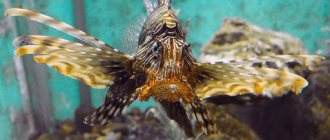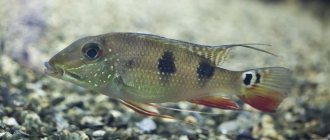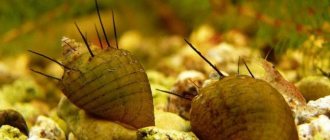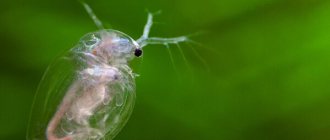Fish
They are common in all types of reservoirs, from marine waters to the smallest ponds, eriks and rivulets.
The tropics and eternal ice are also rich in unusual species of fish. In the reservoirs of Russia, aquatic inhabitants are very diverse and distinguished by their beauty. On the territory of the Russian Federation there are more than 120 thousand rivers, about 2,000,000 lakes, 12 seas, 3 oceans, and all of them are habitats for fish
.
Even in fresh Russian reservoirs, over 450 species of fish
, many of which live permanently, and some arrive temporarily until a certain period.
general information
The study of fish is ichthyology - the science of fish (in Greek “ichthys” means fish, and “logos” means word, mind).
A group of animals called in everyday life " fish
“, unites all aquatic vertebrates that breathe with gills and have paired limbs in the form of fins. From the point of view of a systematic biologist, this group does not represent a single whole.
According to modern scientific concepts, all cyclostomes and fish belong to the phylum Chordata, the subphylum Cranial (Craniata) and are divided into 5 classes: hagfish - Myxini, lampreys - Cephalaspidomorphi (Petromyzontes), cartilaginous fish - Chondrichthyes (Elasmobranchii), chimeras - Holocephali and bony fish
- Osteichthyes.
Catfish platidoras
Platidoras striped is a catfish up to 24 cm long. It has an elongated body of sandy yellow color with wide longitudinal dark brown stripes. There are long whiskers on the head, and there are spikes on the fins. When excited and frightened, the catfish is capable of making fairly loud knocking and clicking sounds.
Platidoras is nocturnal. He spends most of his time during the day buried in the ground, and after turning off the light he goes out in search of food. These striped aquarium fish are kept singly or in groups at a temperature of 24-26°C, pH 5.8-7.5 and dH 2-20°. Platydoras are peaceful, omnivorous and easy to keep.
Fishes of our waters
- White amur
- Chub
- Gustera
- Dace
- Ruff
- Asp
- crucian carp
- Carp
- Klepets
- Smelt
- Rudd
- Bream
- Tench
- Salmon
- Burbot
- Perch
- Gudgeon
- Roach
- Rotan
- Carp
- Whitefish
- Sinets
- Som
- Zander
- Silver carp
- Acne
- Bleak
- Trout
- Grayling
- Chekhon
- Pike
- Ide
External structure of fish
External structure of fish Body shape in fish Scales in freshwater fish Mouth position in fish Morphological structure of fins in fish Structure of gills in fish Structure of pharyngeal teeth in fish
Fish and fish-like fish have a body divided into three sections: head, trunk and tail.
The head ends in bony fishes (A) at the level of the posterior edge of the gill cover, in cyclostomes (B) - at the level of the first gill opening. The body (usually called the body) in all fish ends at the level of the anus. The tail consists of a caudal peduncle and a caudal fin.
Fish have paired and unpaired fins. Paired fins include the pectoral and ventral fins, unpaired fins include the caudal fin, dorsal fins (one to three), one or two anal fins and an adipose fin located behind the dorsal fin (salmon, whitefish). In gobies (B), the pelvic fins have changed into peculiar suckers.
The body shape of fish is related to their living conditions. Fish that live in the water column (salmon) usually have a torpedo- or arrow-shaped shape. Bottom-dwelling fish (flounder) most often have a flattened or even completely flat body shape. Species that live among aquatic plants, stones and snags have a strongly laterally compressed (bream) or serpentine (eel) body, which provides them with better maneuverability.
The body of fish can be naked, covered with mucus, scales or shell (pipe fish).
Scales in freshwater fish of Central Russia can be of 2 types: cycloid (with a smooth posterior edge) and ctenoid (with spines along the posterior edge). There are various modifications of scales and protective bone formations on the body of fish, in particular sturgeon bugs.
Scales on the body of fish can be arranged in different ways (in a continuous cover or in sections, like in mirror carp), and also be different in shape and size.
Mouth position is an important feature for identifying fish. Fish are divided into species with lower, upper and final mouth positions; There are also intermediate options.
- Fish of near-surface waters are characterized by an upper position of the mouth (sebike, verkhovka), which allows them to pick up prey that has fallen on the surface of the water.
- For predator species and other inhabitants of the water column, the final position of the mouth is characteristic (salmon, perch), and for the inhabitants of the benthic zone and the bottom of the reservoir - the lower position (sturgeon, bream).
- In cyclostomes, the function of the mouth is performed by the oral funnel, armed with horny teeth.
- The mouth and oral cavity of predatory fish are equipped with teeth. Peaceful benth-eating fish have no teeth on their jaws, but they have pharyngeal teeth for crushing food.
The fins consist of hard and soft rays, connected by a membrane or free. Fish fins consist of spiny (hard) and branched (soft) rays. The spiny rays can take the form of powerful spines (catfish) or jagged saws (carp).
Based on the presence and nature of the rays in the fins of most bony fishes, a fin formula is compiled, which is widely used in their description and definition. In this formula, the abbreviated designation of the fin is given in Latin letters: A - anal fin (from the Latin pinna analis), P - pectoral fin (pinna pectoralis), V - ventral fin (pinna ventralis) and D1, D2 - dorsal fins (pinna dorsalis). Roman numerals indicate the numbers of prickly rays, and Arabic numerals indicate the numbers of soft rays.
The gills absorb oxygen from the water and release carbon dioxide, ammonia, urea and other waste products into the water. Bony fish have four gill arches on each side.
Gill rakers are the thinnest, longest and most numerous in fish that feed on plankton. In predators, the gill rakers are sparse and sharp. The number of rakers is counted on the first arch, located immediately under the gill cover.
The pharyngeal teeth are located on the pharyngeal bones, behind the fourth branchial arch.
- See also: Appearance of fish
Which one is sold in stores?
If you live far from the sea coast, and fresh sea fish is offered at the market or supermarket, then you definitely need to think carefully. There is a high probability that simple river fish, a defrosted semi-finished product, will be sold. Each region of the country has its own fishery, or even several, from which fish can be supplied to local supermarkets. Sellers must have an official certificate. He will confirm the information regarding the fish supplied. Before purchasing seafood, always try to carefully study this issue. This will avoid many difficulties in the future.
When buying fish in a store aquarium, the main thing you should pay attention to is the purity of the water. Ideally, the fish should swim in the lowest part of the aquarium, where all the healthy, most active representatives of the water element always live.
If you notice that the fish moves little, is lethargic, and is already swimming upside down, then you should refuse to purchase it.
Fish biodiversity data
- In the fresh waters of Russia, representatives of only two classes are found - lampreys and bony fishes.
- About 25,000 species of fish currently live in the waters of our planet.
- At least 2,000 species and subspecies of fish live in the fresh waters of Russia and in the coastal zone of the seas washing it.
- 351 species are found in the continental waters of Russia. If we exclude marine fish, including fish from the Caspian Sea, then typical freshwater fish will account for only 269 species belonging to 136 genera, 28 families and 11 orders.
- The list of fish that you can find in the rivers and lakes of Central Russia consists of at least 100 species.
- This section of the site describes 20 species of freshwater, anadromous and semi-anadromous fish.
Fatty varieties
Fatty fish is characterized by the presence of fat in the abdominal cavity and tissues in the gastrointestinal tract. Its fillet contains about 30% fat, but this figure varies depending on the specific variety of freshwater or marine representatives. If you are asked: “Name the fatty varieties,” then these are sardines, anchovies and herring. Trout and tuna are slightly inferior to salmon, but have a similar fat content.
In terms of content, fatty fish is similar to white fish, which has fat only in the liver. These are cod or flounder, haddock and other species. Such fish is always the best source for vitamins. In most clinics, patients with cardiovascular diseases include these types of marine fish in their diet. It is fatty varieties of fish that can have a positive effect in case of arthritis or other inflammatory diseases.
A well-known fact: fatty fish can contain a lot of mercury and dioxin. This is its main disadvantage.
Types of fish
- Anadromous fish species
are fish species that reproduce in fresh water of water bodies in the Russian Federation, then migrate to the sea to feed and return to their places of reproduction to spawn; - Catadromous fish species
are fish species that reproduce at sea and spend most of their life cycle in the internal waters of the Russian Federation and in the territorial sea of the Russian Federation; - Transboundary species of fish
and other aquatic animals - species of fish and other aquatic animals that reproduce and spend most of their life cycle in the exclusive economic zone of the Russian Federation and can temporarily migrate outside such a zone and into the open sea area adjacent to such a zone; - Transzonal species of fish
and other aquatic animals - species of fish and other aquatic animals living in the exclusive economic zone of the Russian Federation and in the adjacent exclusive economic zones of foreign states; - Highly migratory species of fish
and other aquatic animals are species of fish and other aquatic animals that spend most of their life cycle in the open sea and can temporarily migrate to the exclusive economic zone of the Russian Federation; - Bottom fish
- the name of fish that spend most of their life cycle at the bottom or in the immediate vicinity of it (the latter are also called bottom fish): flounder, halibut, rays, gobies, catfish, etc. However, most of these fish have eggs and larvae pelagic. Cod, haddock, pollock, hake, hake, notothenia, etc. spend a significant part of their lives at the bottom. During the periods of spawning, feeding, and wintering, benthic accumulations are formed, for example, by pollock, herring, capelin, and sea bass. Bottom-dwelling fish feed on benthos or organisms living in the bottom layers of water. Flounder, halibut, stingrays and some other fish have a body shape adapted for living on the bottom, a protective coloration, and can burrow into the ground. Bottom fish are caught using bottom fishing gear (snurrevod, trawls, hook tackle, set nets, etc.). Fishing for fish that sometimes rise into the water column (cod, haddock, etc.) is also carried out using pelagic fishing gear.
Alphabetical list
- Shark
- Albula
- Anchovy
- Apriona
- Argus
- Barabulya
- Barracuda
- Berix
- Bon fish
- Bryzgun
- Bull's Eye
- Goby
- Variola
- Wahoo
- Garrupa
- Gorbyl
- Grouper
- Wrasse
- Jacas
- Jack Fish
- Job Fish
- Dorado
- Astrologer
- Zebrasoma
- Karang
- Caranx
- Crucian sea.
- Mullet
- King Fish
- Stickleback
- Dorado
- Creval
- Lionfish
- Letrin
- Volatile
- bluefish
- Lucian
- Mackerel
- Manta
- Marlin
- Mahi Mahi
- Merluza
- capelin
- Pipefish, angelfish, skate, bream
- Moray
- sailboat
- Pelamida
- Permit
- Haddock
- Platax
- Pompano
- Red snapper
- Rooster
- Angelfish, butterfly, zebra, hammerhead, Napoleon, rhinoceros
- Sawfish, parrot, belt, surgeon
- Sabertooth
- Saida
- Garfish
- Sardine
- Herring
- Seabass
- Sigan
- Scat
- Mackerel
- Snapper
- Snook
- Dog
- Horse mackerel
- Tarpon
- Trachinote
- Cod
- Tuna
- Acne
- Hake
- Chimera
Fishes of economic importance
Industrial fishing
It is known that representatives of the herring family make up the majority of the world's catch. Herring is a schooling fish; it comes in large schools, which serve as a convenient source of cheap food and technical products. Herring fishing has always constituted a major share in the fisheries of Iceland, the Netherlands, Poland, the Scandinavian countries and Russia. Other herrings of primary economic importance include anchovy, sardine and menhaden. The annual production of herrings by all countries of the world is about 15 million tons.
Of the fish of greatest economic importance, we should highlight cod, the fishing of which has been the basis of intensive fishing in the North Atlantic since ancient times. Once upon a time, the annual catch of cod only in the area of the Great Newfoundland Bank (in the northwestern part of the Atlantic Ocean) reached 1 million tons, but already in the early 1990s it fell by more than 70%. Cod makes up the majority of the fish caught by the UK and Icelandic fishing fleets; its catches were of significant importance for the former USSR, and are just as important for Norway now.
Of the migratory fish that spawn in rivers, salmon has the greatest economic importance. It is mined mainly in the states of Washington, Oregon, Alaska and California, as well as in British Columbia, the Russian Far East and Japan. Salmon is also caught in Chile, Australia and New Zealand, where some of its species were once introduced. The growth of salmon products began due to the development of related aquaculture enterprises, and these products have become an important element of international trade. A record amount of canned salmon was produced in 1936 - 9 million boxes, the total net of which amounted to 238 thousand tons. With the development of the market for fish products, less traditional products from fish from the orders of perciformes and cypriniformes began to appear on it. People have been fishing for tuna in the Mediterranean Sea and off the coast of Japan for a long time. However, favorable conditions for the sale of products from this type of fish were created only at the beginning of the 20th century. in connection with the development of tuna meat canning enterprises, which created a new market for these fish on a global scale.
Formidable sea predators
Predators include fish that feed on other marine life, birds, and sometimes some animals. The sizes of individuals can range from small aquarium specimens to those with impressive dimensions. All predators have in common the presence of sharp teeth.
The vast majority live in tropical and subtropical latitudes.
Predatory marine fish that pose a danger not only to neighboring populations, but also to humans:
- Shark. It is the largest predator. The most dangerous is the white shark, the safest is the whale shark. This is a sea fish with keen eyesight; it detects water fluctuations 200 m away. It is found in all water areas; the Black and Caspian seas are considered the safest. In the Black Sea there is a small shark, the Black Sea katran. Cold-resistant sharks live in the White Sea and are also found in the Barents Sea. They do not pose a danger to humans.
- Moray eel. Lives in underwater caves, coral reefs and thickets. Has a strong lightning-fast grip.
- Barracuda. Outwardly it resembles a giant pike, the size can reach 3 m. It is called a sea tiger for the presence of sharp teeth and a sudden grip. It feeds on any food, even if the prey is poisonous. Therefore, the meat of this fish can be dangerous to eat.
- Swordfish. It looks like a torpedo in appearance, and the sword-shaped appendage can reach 1.5 m. The impact force is 4 tons. Individuals develop rapid speed, which surprises ichthyologists. Even sharks are eaten.
- Angler. Lives on the bottom surface. The long fin is used as a fishing rod. Bacteria living on the process serve as bait for other fish. Periodically rises to the surface to catch birds.
There are predatory species that are not dangerous to humans. For example, among the commercial species, tuna is a schooling predator. It feeds on sardines, mackerel, crustaceans and other living creatures. Also distinguished by their predatory lifestyle are:
- bonito;
- flounder;
- bluefish;
- catfish;
- pink salmon;
- Atlantic and Pacific cod;
- croaker;
- laurel;
- rock bass;
- sea ruff
Predators are important to the balance of nature.











